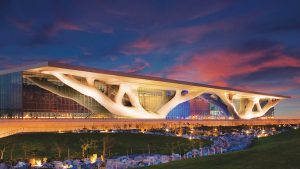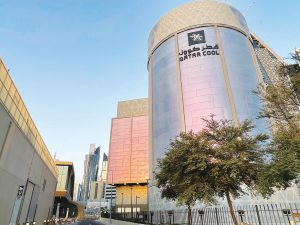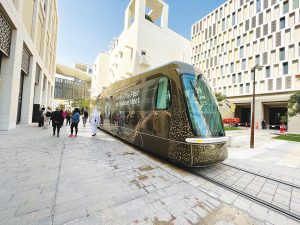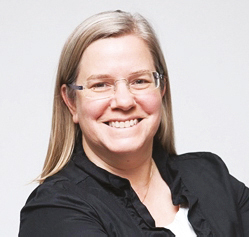Strategien zur Nachhaltigkeit im Staat Katar
Susie Billings, Communications Director of WSCM 23
Da sich die Welt allmählich der Tatsache bewusst wird, dass der Klimawandel schneller vonstattengeht als vorhergesagt, suchen wir alle nach Wegen, wie wir Teil der Lösung sein können.
Katar befindet sich in einer einzigartigen Position. Es ist eine Wüstenregion, einer der größten Produzenten von Flüssigerdgas der Welt und Heimat einer extrem kleinen Bevölkerung. Dies hat dazu geführt, dass Katar in den letzten Jahren als das Land mit den höchsten CO2-Emissionen pro Kopf[1] in die Schlagzeilen geriet. Insgesamt macht Katar jedoch nur 0,3 % der weltweiten Emissionen aus.[2]
Was also tut Katar, um seinen CO2-Fußabdruck zu minimieren?
Grüne Gebäude
Im Zuge der rasanten Entwicklung des Landes lag ein Schwerpunkt auf umweltfreundlichen Gebäuden, wobei große Projekte die LEED-Zertifizierung (Leadership in Energy and Environmental Design)[3] oder die neuere und regional ausgerichtete Zertifizierung des Global Sustainability Assessment System (GSAS)[4] erhalten haben.
QNCC – der Hauptveranstaltungsort des WSCM 2023/24
Das Qatar National Convention Center (QNCC), in dem der Großteil der Aktivitäten für das WSCM 2023/24 stattfinden wird, war das erste Gebäude in Katar, das bereits 2012 die LEED-Gold-Zertifizierung erhielt. Neben den 40.000 Quadratmetern Ausstellungsfläche gibt es 10 Aufführungsorte, einen Konferenzsaal mit 4.000 Sitzplätzen und ein Theater mit 2.500 Sitzplätzen.
Zu den Elementen aus Design und Infrastruktur, die dem QNCC zu dieser LEED-Gold-Zertifizierung verholfen haben, gehört die Installation von 3.500 Quadratmetern Sonnenkollektoren auf dem Dach. Und um die Energieeffizienz drastisch zu steigern, wurden im gesamten Komplex Belegungssensoren, LED-Leuchten und zonenbasierte Luftsteuerungssysteme implementiert. Diese Funktionen arbeiten zusammen, um eine wesentlich nachhaltigere Energienutzung zu gewährleisten.

Viele andere bedeutende Bauprojekte, darunter die meisten Stadien für die FIFA Fußball-Weltmeisterschaft 2022, zeichnen sich durch nachhaltiges Design und nachhaltiges Betreiben aus und haben die GSAS-Zertifizierung erhalten.
Fernkälte
Ein weiterer Zielbereich, der identifiziert wurde, um die Nachhaltigkeit zu verbessern und die Umweltauswirkungen zu reduzieren, sind die Klimaanlagen von großen Gewerbe- und Wohntürmen. Katar ist ein Wüstenland und hat schöne milde Winter, aber sehr heiße und oft feuchte Sommer.
Mit zunehmender Verdichtung und dem Wachstum von Hochhäusern in Katar war klar, dass kostengünstigere und umweltfreundlichere Kühloptionen erforderlich waren. Die Planungen für Fernkälte begannen in den frühen 2000er Jahren und die weltweit größte Fernkälteanlage wurde 2010 in Betrieb genommen, um den als Pearl bekannten Inselbezirk mit allen Klimatisierungsanforderungen zu versorgen. Weitere Fernkälteanlagen wurden in wichtigen Entwicklungen im Hauptgeschäftsgebiet West Bay von Doha, der neuen Stadt Lusail und dem Msheireb-Entwicklungsgebiet in der Altstadt installiert.
Diese große Investition in Fernkälteanlagen stellt den Einsatz hocheffizienter Kältemaschinen und spezieller Rohrleitungen zur Versorgung von Gebäuden innerhalb einer Nachbarschaft sicher, wodurch der Energiebedarf für den Gebäudekomfort drastisch reduziert wird. Allein ein einziges Wohnviertelprojekt wird schätzungsweise „12,6 Millionen kWh pro Jahr im Vergleich zu ähnlichen konventionellen Kühlern einsparen“.[5]

Mangrovenschutz
Die meisten Fotos von Katar zeigen malerische Felsvorsprünge im Norden oder die zahlreichen Sanddünen im Süden des Landes, aber Katar hat auch ein kleines und fragiles Ökosystem von Mangroven an seiner Ostküste, 60 km nördlich der Hauptstadt Doha.
Weltweit haben Wissenschaftler ein besseres Verständnis der großen Bedeutung von Mangroven als CO2-Speicher und Lebensraum für Vögel, Fische und andere Tiere gewonnen und verbreitet. Aktuelle Schätzungen gehen davon aus, dass Mangrovenwälder fünf- bis achtmal so viel Kohlenstoff speichern wie boreale oder tropische Wälder. Neben der Kohlenstoffbindung ist die Mangrove von Katar eine wichtige Station für eine Vielzahl von Zugvogelarten, einschließlich Schwärmen von Flamingos.
In den letzten Jahren hat die Regierung Schritte unternommen, um die Küste von Katar zu schützen, wobei 40 % davon als Schutzgebiet[6] ausgewiesen wurden. Das Ministerium für Gemeinde und Umwelt überwacht den Mangrovenwald von Al Zakhira und repariert Schäden, die durch den zuvor unbegrenzten Zugang von Besuchern verursacht wurden. Es gibt jetzt einen erhöhten Gehweg, um die Mangroven zu erkunden, ohne die empfindlichen Wurzelsysteme der Pflanzen zu beschädigen.

Entsalzungsanlagen
Während Katar über eine Reihe von unterirdischen Grundwasserleitern verfügt, die traditionell verwendet wurden, um das Leben in der Wüste zu erhalten, erforderten das explosive Bevölkerungswachstum und die Entwicklung der Öl- und später Erdgasindustrien eine größere Wassermenge und eine nachhaltigere und zuverlässigere Quelle.
Katar begann 1955 mit der Entsalzung von Meerwasser und baut seine Produktions- und Speicherkapazitäten weiterhin rasch aus. Bei einer Bevölkerung, die von 500.000 Menschen Anfang 2000 auf über 2,7 Millionen heute angewachsen ist, ist zuverlässig entsalztes Wasser überlebenswichtig. Die Herstellung von sauberem Trinkwasser ist jedoch mit erheblichen Energiekosten verbunden. Katar investiert derzeit stark in die Verbesserung der derzeit eingesetzten energieintensiven thermischen Entsalzungssysteme und erweitert die Kapazität durch neue Anlagen, die das energieeffizientere Umkehrosmose-Entsalzungsverfahren verwenden.[7]

Forschung & Entwicklung
Katars wichtigste Quelle des Reichtums sind fossile Brennstoffe, hauptsächlich sauberer verbrennendes Erdgas; Die nationale Führung erkennt jedoch auch an, dass Katar viel Sonnenschein hat, von Natur aus wasserarm und derzeit auf Gasreserven angewiesen ist, die nicht ewig halten werden.
Partnerschaften und Investitionen in Forschungsprojekte im Katar Science and Technology Park (QSTP)[8] sind für die Zukunft Katars von grundlegender Bedeutung. Seit 2010 werden unter dem Dach des QSTP Projekte durchgeführt, die neue Lösungen für Solarenergie, Wassereinsparung, Ernährungssicherheit und andere technologische Innovationen untersuchen. Der Schwerpunkt der hier versammelten Institutionen liegt darauf, Lösungen für Probleme zu finden, die für Katar und die Region spezifisch sind – wie zum Beispiel Komplikationen bei der Implementierung von Solarenergie. In Katar gibt es das ganze Jahr über viel Sonnenlicht, aber es gibt auch regelmäßig Sandstürme, die traditionelle Sonnenkollektoren beschichten, bedecken und zerkratzen können, was ihre Leistung erheblich beeinträchtigt. Die Forschung nach innovativen kostengünstigen Lösungen wird zu diesem und anderen lokal relevanten Themen der Nachhaltigkeit fortgesetzt.
Während wir alle nach Wegen suchen, die Welt zum Besseren zu verändern, freut sich Katar darauf, weiterhin eine Kraft für den Wandel zu sein. Zuletzt hat sich Katar mit den USA, Norwegen, Saudi-Arabien und Kanada zusammengeschlossen, um ein Net-Zero Producers Forum zu bilden und kooperativer zusammenzuarbeiten, um pragmatische Netto-Null-Emissions-Strategien zu entwickeln.[9]

Besucher in Katar zur WSCM 2023
Katar führt weiterhin aktiv neue Infrastrukturen mit Fokus auf Nachhaltigkeit ein. Wenn Sie Katar zur WSCM 2023/24 besuchen, können Sie mit Qatar Airways fliegen, die eine der jüngsten und treibstoffeffizientesten Flotten betreibt und Teil des IATA-Kohlenausgleichsprogramms ist.[10] In Doha angekommen, können Sie mit brandneuen öffentlichen Verkehrsmitteln reisen, darunter ein U-Bahn-System, oberirdische Straßenbahnen und in Kürze eingeführte Elektrobussen.[11]
„Als Katar sich um die Ausrichtung der FIFA Fußball-Weltmeisterschaft 2022 bewarb, tat es dies mit der Vision, das Turnier als Katalysator für nachhaltige, langfristige Veränderungen in Katar und in der gesamten arabischen Welt zu nutzen“, sagte der Vorsitzende von Qatar22, SE Hassan Al-Thawadi.[12] Da das World Symposium on Choral Music nur ein Jahr nach der Ausrichtung der FIFA Fußball-Weltmeisterschaft in Katar stattfindet, werden die Symposiums-Teilnehmer von den umfangreichen und anhaltenden Bemühungen in Katar profitieren, ein nachhaltigeres Leben zu schaffen und zu leben.
 Susie Billings ist eine Weltbürgerin, die auf vier Kontinenten gelebt und gesungen hat. Sie lebt seit 2007 in Doha, Katar. Seit der High School sang sie in Musicals, als Kirchensolistin und in Leistungschören und A-cappella-Gruppen. Wenn sie nicht singt, arbeitet sie für eine Vielzahl von Organisationen auf der ganzen Welt und setzt sich für Gender und Menschenrechte ein.
Susie Billings ist eine Weltbürgerin, die auf vier Kontinenten gelebt und gesungen hat. Sie lebt seit 2007 in Doha, Katar. Seit der High School sang sie in Musicals, als Kirchensolistin und in Leistungschören und A-cappella-Gruppen. Wenn sie nicht singt, arbeitet sie für eine Vielzahl von Organisationen auf der ganzen Welt und setzt sich für Gender und Menschenrechte ein.
Übersetzt aus dem Englischen von Heide Bertram, Deutschland
[1] https://ourworldindata.org/per-capita-co2
[2] https://ourworldindata.org/co2/country/qatar
[3] Zuerst entwickelt von US Green Building Council 1993
[4] 2007 als Standard für den Mittleren Osten und Nordafrika geschaffen – Projekte, die bereits zertifiziert sind, kann man hier sehen: https://www.gord.qa/gsas-projects
[5] https://www.utilities-me.com/article-2605-msheireb-opts-for-district-cooling
[6] https://forestsnews.cifor.org/13101/qatars-mangroves-why-they-matter-to-climate-change?fnl=
[7] H Rahman, Syed Javaid Z. Desalination in Qatar: Present Status and Future Prospects. Civil Eng Res J. 2018; 6(5): 555700. DOI: 10.19080/CERJ.2018.06.555700.
[8] https://qstp.org.qa
[9] https://www.energy.gov/articles/joint-statement-establishing-net-zero-producers-forum-between-energy-ministries-canada
[10] https://www.qatarairways.com/en-us/about-qatar-airways/environmental-awareness.html
[11] https://www.sustainable-bus.com/news/yutong-mowasalat-fifa-world-cup-2022-qatar/
[12] https://www.fifa.com/what-we-do/sustainability/strategy/